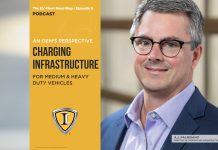BOSTON — Boston Public Schools is holding a hackathon to get to the root of its bus routing problem, which has plagued the school district for at least seven years, when it moved from a pen-and-paper process to using computer algorithms, according to the Boston Globe.
The issue for Boston Public Schools is transporting about 30,000 students who are assigned to ride 642 school buses to and from school—on time—every day in a city that is known to have congested streets.
“We have 5,000 stops in our system,” said William Eger, a strategic project manager with the district. “This isn’t just a BPS problem. This is a really tricky computer science problem that folks like Google Maps, who are the industry leaders in this, have looked at.”
The district invited a bevy of academics and computer science experts from Google, Microsoft, Uber, Harvard, and MIT, to descend on District Hall in South Boston for the Transportation Challenge: Solving Routing and Bell Times.
The event this Saturday will operate like a hackathon, although unlike similar events there will be no sprint to come up with solutions on a super-tight deadline, say 24 to 48 hours. The teams assisting BPS will have two to three months to come up with solutions to the district’s transportation woes.
Those in the room on Saturday will listen to a discussion by a panel that includes Superintendent Tommy Chang before heading into breakout sessions to have what John Hanlon, the school department’s chief of operations, calls “really exciting conversations rich with data.”
They will parse how school bus routing works, where school bus stops are located, school start times, and the policies that complicate the situation.
Then the tech teams will mine the data BPS gives them and come up with solutions off-site.
The goal is to discover new algorithms that improve bus routes by making them more efficient, automated, and accurate—but also flexible—by mid-May, Hanlon said.
The district has grappled with entrenched transportation woes since the 2010-2011 school year, when it switched to a new software system called Versatrans after years of creating routes via pencil and paper. The computer program was supposed to make school buses run more efficiently. Instead, it caused system-wide headaches.
At one point, a quarter of the buses were late, sometimes up to an hour after the first bell rang. And the district’s staggered start times—7:30, 8:30, and 9:30 a.m.—can be thrown out of whack by one late route.
The situation has improved dramatically, but BPS still fails to deliver 100 percent of students to school before classes begin.
Phase two of the hack is tackling school start times, Hanlon said.
The winning proposals from both challenges will be announced at the end of June.
The district is cautious as to whether the ideas will be implemented next school year. It’s possible some of the bus routing concepts might be implemented immediately. But any changes to school start times won’t come until the 2018-2019 school year, Hanlon said.
“It would be too disruptive to do that to families at this point,” he said. “And quite frankly, we want the start-time piece to be based on a lot of engagement with schools.”
The district continues using Versatrans, which Hanlon said would be involved in the Transportation Challenge. But he said, the system “leaves a lot to be desired.”
The district feeds all of its student data into the computer system, which generates bus routes. Those routes must then be “fine-tuned,” he said. “It’s a very heavy lift for all of our staff and places an extra burden on them that we’d like to avoid.”
But Andre Francois, head of the Boston School Bus Drivers Union, said, “human experience on the road, not machines controlled by technicians,” is the only way to perfect bus routes.
Some routes, he said, give drivers 15 to 20 minutes to go from Charlestown to schools just beyond the Expo Center in Dorchester “at a time when it’s stop and go, stop and go, stop and go, like a parking lot on the highway. By the time you get there, it’s like an hour.”
“A machine doesn’t see the ice cream truck. A machine doesn’t see the trash truck or the funeral lines. It doesn’t see the problems with the routes,” he said. “Put somebody out there on the bus that goes out and does a dry run and then records the real-time it takes to do the route.”
















